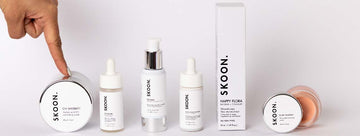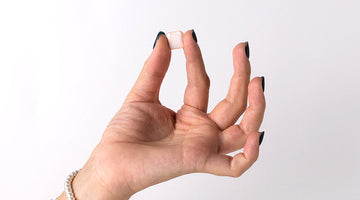Are you looking to better understand skin types and the fundamentals of skincare? Then you’ve come to the right place! By now you have probably heard a thing or two about how we classify skin and skincare according to one of the five general skin types, with each being defined by the skin symptoms we experience on a daily basis, and the general nature of our skin.
Namely, these skin archetypes are dubbed normal skin, dry skin, combination skin, oily skin and sensitive skin.
But how do you know which one you have - or how to build a skincare routine according to your skin type?
That’s where we can help. Read on, to find out more about each skin ‘archetype’ and learn everything you need to know about different skin types, their characteristics, symptoms, and causes behind skin issues, and most importantly - which ingredients are best to treat any daily skin issues you may be experiencing.
Let’s chat about the specifics of the five skin types below!
Table of contents
What are the 5 different skin types?
Understanding your skin type is crucial to designing an ideal daily skincare routine that works effectively to nourish your skin, and treat any issues you might be experiencing.
Although everyone’s skin is unique, some of your skin symptoms will form part of the different skin types, and make it easier for you to identify potential treatments to properly nourish your skin.

Normal skin
If you’re one of the lucky ones blessed with little-to-no skin concerns or symptoms and a smooth complexion, you may have a normal skin type. This skin type is very low maintenance and really just requires good basic care and protection to be at it’s best.
Let’s delve into the traits of the normal skin type and how to care for it.
Normal skin traits & characteristics
Normal skin is radiant, with a smooth supple feeling to the touch. It’s well-nourished, with a natural glow, and exhibits no signs of dryness, visible or underlying irritation, flakiness or oiliness.
While this sounds too good to be true, and exactly like the skin type we would all love to have, the normal skin type can suffer from a variety of skin concerns. Issues such as hyperpigmentation, fine lines and wrinkles, and even seasonal oily skin or dry skin.
If you are lucky enough to have normal skin that looks and feels amazing, avoid being complacent! A good skincare routine and a few key ingredients can help you to maintain your normal skin type, protect your skin barrier, and treat any skincare concerns that arise, to keep your skin in tip top shape.
Best ingredients for normal skin
Maintaining normal skin is simple, but starts with a good daily skincare routine and incorporates beneficial ingredients to assist with proper cleansing, nourishment and treatment of any skin concerns that may arise.
Keep it simple, with a good, mild, cleanser like our GEL-TO-MILK Cleanser to gently cleanse the skin (regular use of purifying and detoxifying cleansers can prove a little harsh and dehydrating for this skin type) followed by a good moisturiser like our ‘The One’ moisturiser for fast-absorbing balanced moisture.
You can then add serums, masks, and concentrates to your daily skincare routine to target any skin concerns you may have. We have listed a few of our favourite ingredients and products for treating different normal skin type concerns below:
If you are looking to revive dull skin and get that dewy glow, vitamin E and squalane are the ingredients for you. These powerful antioxidants nourish the skin and make it shine. Try our Glow Drops for a skin pick-me up.
If you are prone to the odd breakout, zinc is great for preventing acne. It is particularly effective inside a nourishing sunscreen that will help provide protection from UV rays, which break down the skin’s barrier.
If you are worried about pigmentation or skin ageing, Vitamin C is another great ingredient that protects and maintains the skin. This hero ingredient is an incredibly useful antioxidant-rich ingredient that provides a number of skin benefits, including brightening, reducing pigmentation as well as combating age by clearing free radicals and stimulating collagen production, for skin that looks healthy, and feels firm.
For dry and ageing skin concerns, hyaluronic acid is a great moisturising ingredient that penetrates the skin and nourishes its deeper layers. Although you may not suffer from constantly dry or flaky skin, you may experience a ‘dry skin day’, during the summer or winter months, and feel your skin needs a boost of hydration. Try our Ruby Marine overnight hydrating mask for when your skin needs a boost of hydration!

Dry skin
Dry skin! Arguably, one of the most common skin types for us as South Africans who experience dry heat during the summer in particular.
Dry skin is often characterised by a set of niggling skin issues that occur on the face and body, that can be solved, over time, with some TLC.
Dry skin traits & characteristics
Those experiencing dry skin are likely to encounter rough, sensitive and itchy patches of skin that often occur most commonly on the face and neck.
Other dry skin symptoms include flaky skin and a feeling of tightness.
Causes of dry skin
Dry skin is caused by the breaking down of the skin’s barrier, allowing crucial moisture to escape the surface layers of the skin.
Dry skin often goes hand in hand with sensitive skin, for which we’ve written a comprehensive guide to help you understand the science behind the causes and symptoms of dry skin, with all the specifics you need to know.
Best ingredients for treating dry skin
Dry skin benefits from products containing high quality, nutritious oils, butters, anti-inflammatory actives, soothing botanicals, and barrier repair blends which contain a balance of free fatty acids, sterols and ceramides.
The focus of a skincare routine for dry skin should be on gentle cleansing, quality hydration, and protection, to restore moisture and repair the damaged skin barrier. Start by cleansing with a gentle, nourishing cleanser like our GEL-TO-MILK cleanser which provides hydration while removing makeup and impurities from the skin - perfect for dry skin!
Hydration that restores moisture AND repairs the damaged skin barrier is key. Follow up your cleansing with a rich moisturiser high in hyaluronic acid, omega oils, and ceramide - like our Beautifuel Double thick face cream, to restore moisture. Banish those dry flaky patches and tight skin feel!
For even better targeting of dry, flaky or dull skin you can add Rosehip oil and vitamin C to your routine. These ingredients provide a host of antioxidants and unsaturated fatty acids to counter-balance inflammation and oxidative stress from UV exposure and other environmental stressors. Use a product like our ROSEHIP C+ concentrate at night - and wake up to glowing, hydrated skin!
For anti-ageing and dry skin concerns, you can’t go wrong with hyaluronic acid which we covered above.
You can find out more about the best ingredients to use to treat dry skin in our Ultimate Guide to Dry and Sensitive Skin.

Oily skin
Oily skin, the bane of every teenager’s life - and many adults too. This one is probably the most obvious to spot and hardest to get under control. An oily skin type is defined by a shiny skin complexion and excess oil/sebum production that feels greasy.
Oily skin traits & characteristics
Oily skin is a result of excess sebum production which traps bacteria on the skin and in pores and more often than not, is associated with recurring skin breakouts, acne, blackheads (you might be familiar with pesky black nodes around the nose) and clogged pores.
While your skin type is typically genetic, oily skin can be caused or worsened by your diet, environmental factors, or poor skincare practices such as excessive or harsh cleansing, and using the wrong ingredients.These factors all lead to the overproduction of sebum, and result in slick patches of skin characteristic of an oily skin type.
Best ingredients for treating oily skin issues
To treat oily skin, you should ensure that your diet and lifestyle are supportive of, and not hindering, your skincare goals. Once other factors are under control, you can focus on building a good skincare routine for your oily skin. You need to provide oily skin with the right amount of cleansing and moisture in order to restore natural order to your skin’s processes and get your natural oil production in balance.
Cleansers need to purify the skin, but still be gentle, and need to contain ingredients that don’t harm the skin further. While you may be tempted to cleanse several times a day, these products must not be used too frequently as this can stimulate oil production. The best ingredients to look for in a gentle cleanser include vitamin A (retinal) and fulvic acid, which is a soft cleansing ingredient, as well as zinc PCA, which is helpful in combating acne and skin breakouts. Try our WHITEWASH Purifying clay cleanser.
We cover the benefits of vitamin A comprehensively in our guide Everything You Need to Know About Vitamin A in Skin Care.
Moisturising your skin is also important to maintain a normal level of moisture and prevent the over-production of sebum from beneath the skin’s surface. Another great ingredient for moisturising oily skin is hyaluronic acid, a powerful hydrating compound, which we also cover in detail in our post 9 Benefits of Hyaluronic Acid in Skin Care. Try our Pretty Smooth moisture gel which will provide light moisturising while helping restore balanced oil production in your skin.
To treat the common oily skin problem of breakouts, clogged pores, and excess oil, ingredients like zinc are your best friend. We covered zinc in a bit more detail above. For oily skin you can try our Mineral Matte Oil Control Serum which helps to control breakouts and clarify the skin.
For gentle but effective exfoliating a pore cleaning, azelaic acid is a great choice for effective and long lasting cleansing, without stimulating further oil production. Find out more about azelaic acid in our blog post: Everything you need to know about Azelaic Acid in Skincare.

Sensitive skin
Sensitive skin is a skin type on its own, but you can also experience sensitive skin as a symptom or in combination with one of the other skin types, specifically when you’re experiencing dry, damaged skin.
This is one of the more difficult skin types to get under control as it often gets worse before it gets better. You might find, at first, that you react to products even if they help with sensitivity in the long run.
Sensitive skin characteristics and traits
Sensitive skin is usually quite reactive, and you may experience patches of burning, stinging and itchy skin on your face or on other parts of your body.
On the surface, sensitive skin may appear red or even flaky, at times, and sensitive skin symptoms may be a part of larger skin conditions such as rosacea or eczema.
If you regularly have patches of sensitive skin, you may have an impaired skin barrier which can be an key issue to spot and treat. We have a quick checklist that can help you determine whether you have an impaired skin barrier, and what the causes of your damaged skin barrier might be.
Best ingredients for treating sensitive skin
Sensitive skin is trickier to treat than some other skin types, and tends to be more reactive to a wider range of ingredients - which is why we’ve assembled a few of our favourites below. A useful tip with sensitive skin is to start new products slowly and gradually build up to the recommended use.
Starting with cleansing, the key to nurturing sensitive skin is to be gentle. Use gentle cleansers like our Gel to Milk cleanser, and avoid harsh ingredients and cleansing products.
When it comes to moisturising, we want to provide a good dose of hydration, as well as support and healing, for the damaged skin barrier. Magnesium Carboxymethyl Beta-Glucan is a renowned ingredient for strengthening sensitive skin, soothing skin irritation and itching by reducing inflammation. Try it for yourself with our Phyto Light Moisturiser which soothes skin and restores suppleness.
If your skin concerns include dry skin issues, a slightly richer cleanser and moisturising cream might be better for your skin. Schisandra Extract, a key ingredient inside our double thick creamy, moisturiser BEAUTIFUEL, is another big idea for soothing and properly nourishing sensitive skin, reducing inflammation in the process. This anti-inflammation action is also the reason why Schisandra Extract is a useful ingredient in cleansers, to minimize irritation, and is one of the reasons it's included inside our Nkuto Butter Cleanser - which also contains Shea Butter, another moisturising ingredient that nourishes the skin effectively.
Irritation and redness are common concerns associated with sensitive skin. Squalane is a wonder soothing and calming ingredient. Add it to your skincare routine as a concentrate to help soothe and calm redness and irritation. Try our Squalane Concentrate to coax out your inner glow!
As mentioned before, sensitivity and dryness are commonly associated skincare concerns and even if your sensitive skin isn’t dry, it could probably benefit from the reparative effects of hyaluronic acid, for the skin barrier. We’ve already covered the benefits of hyaluronic acid above.

Combination skin
Combination skin can be confusing to identify, at first, due to it’s conflicting symptoms.
You might think you’re suffering from dry skin one moment, and the next, your skin’s surface is visibly shiny, and oily to the touch, making it hard to understand what’s going on beneath the surface - the best course of action, to remedy your skin and restore its naturally healthy complexion.
Combination skin characteristics & traits
Combination skin is characterised by patches of oily and dry skin that occurs most commonly on the face, but can also present on the hands and other parts of the body.
On the face, you may encounter patches of oily skin, with a shiny surface appearance in the T zone, including the forehead, around the nose and down to the cheeks. The oily T-zone is contrasted with dry flaky skin on the cheeks and at times on the forehead too.
Combination skin may also be prone to breakouts and blackheads, which means you might need the right ingredients to clear your pores and strengthen the skin barrier effectively.
Best ingredients for treating combination skin
To combat combination skin effectively, you’ll need to start by repairing and strengthening the skin’s barrier. This will help regulate sebum production in oily patches and improve the condition of dry spots. Some of the ingredients we recommend for combination skin may include ceramides, fatty acids, and antioxidants.
Since your skin has oily patches, you’ll need to start with a gentle cleansing ingredient - or ingredients - that effectively unclogs pores and reduces oiliness by sloughing off dead skin cells to help restore natural levels of sebum production. You don’t want anything overly harsh, however, as this could lead to sensitivity of the dry skin patches. A good, gentle exfoliating ingredient is fulvic acid, included in our Whitewash Purifying cleanser, along with zinc, which is ideal for preventing breakouts - and because it’s a powerful antioxidant, it helps guard against harmful UV rays.
If you’re looking for a good moisturising ingredient to use during your daily skincare routine, to ease those patches of sensitive, dry, flaky skin, we’d recommend hyaluronic acid which can penetrate into the deeper layers of skin to provide thorough moisture and nourishment. While it provides targeted moisture it won’t cause excessive oiliness as the hyaluronic acid will support and help regulate natural sebum production. And that’s exactly why we included it in THE ONE Super Moisturizer.

A common skin concern of combination skin is dullness. To treat dullness and provide a moisture boost to dry areas, we love Vitamin C as our hero ingredient. Try our Wow-Wow Wonder hydrating serum to revive dull skin!
If you are looking for a little extra cleansing and exfoliation, try our Oh Sherbet Azelaic acid exfoliating mask which we covered above.

Wrapping up
We hope you’ve found all of the info you need, to help identify the different skin types, and hopefully you now have a better idea of what your skin type is? If you’re looking to be 100% sure, we've created a short but incredibly helpful skin assessment quiz to help you determine your specific skin type, and find products that can help you improve any current skin issues you’re experiencing.
If you already know which skin type you are and want to get started with skincare products that make your skin the best it can be, you can shop our dry, oily, sensitive, normal, and combination skin starter kits today!
We touched on it very briefly, but it needs to be said that diet and lifestyle are important factors in reaching your skincare goals. If you’re interested in solutions to skin issues from a non-topical perspective, and you’d like to improve your skin by using nutricosmetics to supplement and support elements of your diet, check out our new Beauty Smoothies range. This includes three beauty smoothies which contain all the most essential ingredients that your body needs to maintain and protect your natural complexion. If you’re not yet sure what nutricosmetics are, have a look through our Ultimate Guide to Nutricosmetics to find out more!





